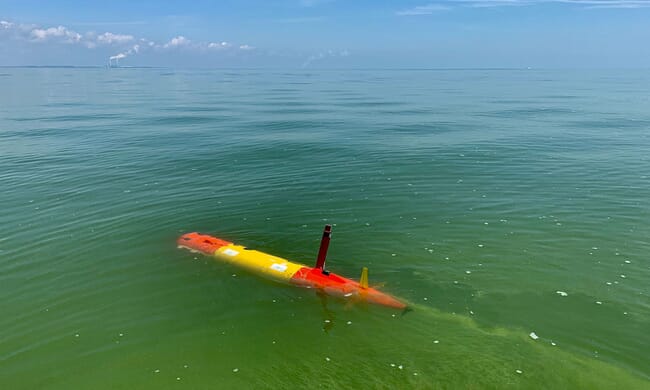
One of Monterey Bay Aquarium Research Institute's (MBARI) long-range autonomous underwater vehicles (LRAUV) makes its way through the green, algae-rich waters of Lake Erie to track the 2019 harmful algal bloom as part of a research collaboration with NOAA. © Ben Yair Raanan, Monterey Bay Aquarium Research Institute (MBARI)
“New projects will begin in Florida, Louisiana, Ohio and Washington to investigate the effectiveness of clay dispersal as a technology to control Karenia brevis blooms in the coastal environment of Southwest Florida; enhance the freshwater HAB toxin detection capabilities of autonomous underwater vehicles; and optimize an early warning system to support the mitigation of shellfish-killing HAB toxins in the Pacific Northwest,” said David Kidwell, NOAA NCCOS competitive research program director in a press release. “Through NCCOS, NOAA continues to fund the latest scientific research to support managers and coastal communities across the country trying to cope with increasing and recurring toxic algae that continue to affect environmental and human health.”
HABs can produce toxins or cause other harmful effects that can damage ecosystems, disrupt aquaculture operations, impact economies and threaten human health.
Marine and fresh waters of the United States are increasingly impacted by HABs, with blooms reported in nearly every state. They cause annual economic losses up to $100 million on average and costs from a single major HAB event can reach tens of millions of dollars. Investments in these projects represent a coordinated effort within the National Ocean Service to advance our nation's ability to observe, monitor, forecast, and manage blooms.
NOAA’s National Centers for Coastal Ocean Science (NCCOS) is allocating $12.4 million for harmful algal bloom research, including $834,000 for three new research awards and $11.6 million for 25 continuing awards. Funded projects will optimise early warning of shellfish-killing algae; enhance detection of HAB toxins; test the use of HAB control methods in marine and freshwater; improve HAB forecasts; and investigate the social and economic impacts of HABs. A full list of the new grant awards is available online.
NOAA’s U.S. Integrated Ocean Observing System Office (IOOS) is allocating $2.8 million for National Harmful Algal Bloom Observing Network’s related activities. Eight IOOS Regional Associations will receive a combined $1.5M million for two new and five continuing NHABON pilot programs to support detection, forecasting, and monitoring of HABs. An additional $1 million will be used to establish an initial HABs monitoring and detection test bed in the Gulf of Mexico and $314,000 for a continuing Ocean Technology Transition (OTT) project
“Projects funded this year cover most of the U.S. continental coast, including the Great Lakes, and Alaska. These have been developed by the IOOS Regional Associations in partnership with local communities and research institutions to address known needs and coverage gaps in their region,” said Carl C Gouldman, director of the US IOOS Office. “IOOS will continue to leverage local and national resources and expertise to identify innovative methods to address coastal hazards like HABs which pose a threat to lives and livelihoods everywhere.”




